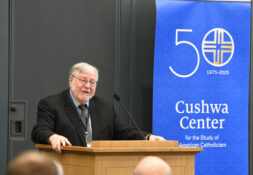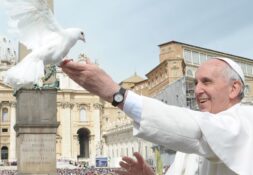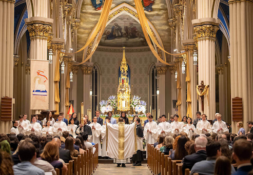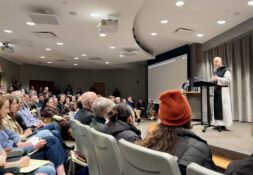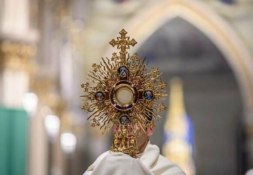Reflections on the Eucharistic Real Presence on campus
“Jesus is with you” and “God is present” are common phrases, but they often exert little influence on listeners. They can be overused or difficult to understand properly and practically because people do not typically think in spiritual terms. One common misconception is that everything spiritual is symbolic and everything symbolic is not truly real.
Although Scripture and theology will incorporate symbols to explain concepts, not everything is symbolic. For example, the grace of absolution from the Sacrament of Confession exists in reality and truly forgives a person’s soul. From one moment to the next a person can transfer from the state of damnation to the state of salvation. This grace might be invisible, but it is not symbolic. It is real.
Furthermore, Christ provides humanity with not only spiritual but also physical gifts. He gave certain believers the power to perform miracles (Mark 16:17-20), beginning with the Apostolic Age and continuing through the lives of the saints. These visible realities serve as reminders of greater spiritual realities. Many people are deeply fascinated by miracles and have pondered them extensively.
Yet all these miracles combined do not even remotely compare to the greatest gift Christ gave humanity—Himself. With His own body, He bore our sins (1 Peter 2:24) and made salvation possible. In addition, He gave priests the power to consecrate bread into His very own body. Has anyone heard of a more life-changing reality?
Although people often doubt this claim. According to a 2019 Pew Research Center survey, less than a third of Americans who identify as Catholic believe in the Real Presence. However, one can determine the truth of this teaching by reading what Christ and His earliest followers said about it. Let us not forget that Christ took bread and clearly said, “This is my body,” (Luke 22:19). This statement was recorded explicitly by four independent sources within a few decades afterwards.
Some may characterize this event as symbolic language at a casual meal. However, the context was the Passover (Luke 22:15), and the consecration of the bread was part of a religious ritual with blessings and a solemn declaration. Others still claim the Eucharist is not Christ’s flesh and blood but symbolic food. But did not Christ say the exact opposite?
“My flesh is real food, and my blood is real drink,” (John 6:55, emphasis added).
One might imagine that if the Eucharist truly is Christ’s body and blood it should be treated with the utmost reverence. St. Paul understood this well and warned the early Christians not to receive the Eucharist unworthily (1 Corinthians 11:27-29). This would be meaningless if the Eucharist were a mere symbol.
Other Christian figures directly expressed their belief in the Real Presence as early as the first century after Christ’s death. Around AD 190, St. Irenaeus wrote that when the bread and wine receive the Word of God they become the body and blood of Christ. Around AD 350, St. Cyril of Jerusalem wrote that even though the Eucharist looks and tastes like bread it is not bread at all but the body of Christ.
If doubts still linger, the dozens of scientifically verified Eucharistic miracles over the centuries may dispel them. The image above features one example, the Miracle of Lanciano. Other miracles have taken place in Poland, Argentina, and elsewhere. In most of these miracles, the consecrated host has started to visibly bleed. Many of these miracles were studied in laboratory settings and analyzed by doctors, some of whom were atheists who consequently converted. Not only have these miracles been photographed and documented, but also they can be visited and seen directly.
What then is the proper response to His Real Presence? One could imagine visiting the tombs of the greatest and most powerful figures in history. Better yet, one could imagine his absolute favorite celebrity of all time entering the room and coming face-to-face with him. People are often left in awe at such occurrences and even faint on occasion.
Yet no one—celebrity, king, or otherwise—is remotely as important as the King of the Universe, Jesus Christ. As soon as He enters the room, or as soon as we enter a room where He is present, they should immediately adopt a spirit of profound awe.
Notre Dame is blessed with great sacramental abundance in its Masses, chapels, priests, and basilica. Those who know of the basilica’s reliquary chapel are fascinated by the physical remains we have retained from the saints. To put things in perspective, we must realize that as valuable as they are, they pale in significance when compared to the Eucharist.
With dozens of chapels, not only in each dorm but also in academic buildings, students have the incredible opportunity to pray before a tabernacle or gaze at Christ face-to-face. Coleman-Morse, the home of Campus Ministry, has eucharistic adoration every weekday. Walking to class, we pass by Him several times a day. Even while crossing the hall in our dorms, we might pass by or above the chapel in which Jesus Christ is literally and physically present.
When we reflect on the teachings of Christ and the Church, we realize the truth of the Real Presence and the astounding significance it has for our day-to-day lives. Statements such as “Jesus is with you” could never remain fluffy or symbolic. They become both powerful and literal.
Christopher de la Viesca is a freshman in Baumer Hall. He is double majoring in mathematics and theology. He also has a passion for music and plays the piano. Contact him at cdelavie@nd.edu.
Photo credit: Image of the Eucharistic Miracle of Lanciano, by Junior. 1 May 2006 – image is in the public domain.
